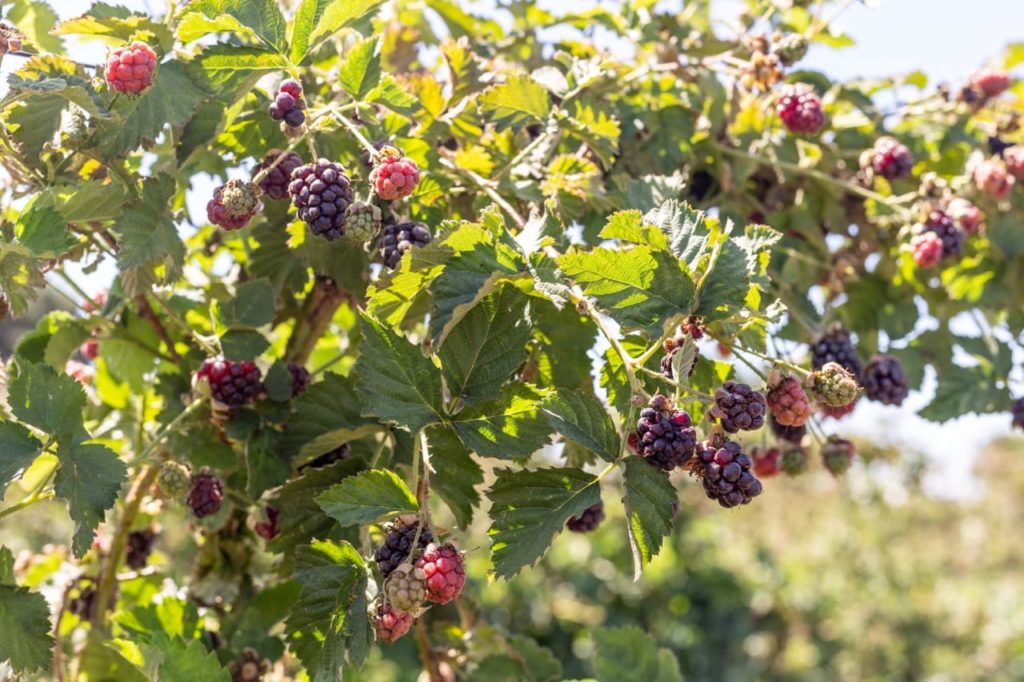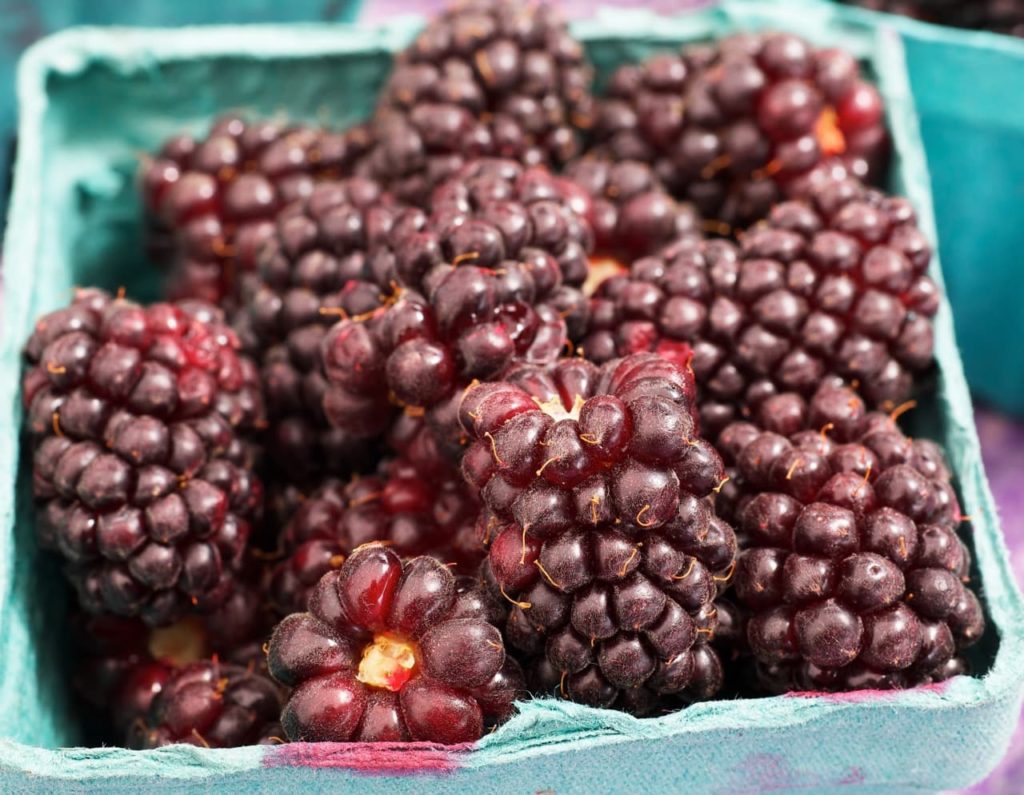FRUIT > BOYSENBERRY
IN THIS GUIDE
BOYSENBERRY GUIDES

While the juicy boysenberry ’s balance and savour vary by ripeness , at any given point it combines such luscious tones of angelical , lemonlike and tart that you ’ll want another handful .
Made to arrange for Charles Edward Berry - lovers , the Boysenberry is a Raspberry , Blackberry , Dewberry and Loganberry all rolled up into one .
develop by Rudolph Boysen in California in the early twentieth century , this berry see its highs and lows in popularity over the succeeding decades.1The Boysenberry and The Chicken Dinner . ( 2022 , May 2 ) . CSUN University Library . Retrieved September 5 , 2023 , fromhttps://library.csun.edu/SCA/Peek-in-the-Stacks/walter-knott

Overview
PreferredFull sun
ExposureSheltered
Height1 – 2 thou

Spread1 – 2 M
PreferredMost productive soils
MoistureWell - enfeeble

pHNeutral
newfangled cultivar , admit thornless single , were developed and Boysenberries advance popularity in newfangled regions , such as the UK , though they struggled to hold that popularity .
Boysenberry is a bramble or aggregative fruit , like the ones it is derived from , which looks like an oblong and considerably heavy , deep purple blackberry .

These wonderful berries merge perfumed , lemonlike and sharp flavours .
They are rather soft and do not keep and transport well but they are absolutely mouth - watering when enjoyed overbold .
what is more , these berries are simply terrific for preparing preserves , sauces , compotes and pies .

As for the Boysenberry bush , it transport up appeal canes that may be mistaken for vines .
How To Grow Boysenberry
Boysenberry George Walker Bush will flourish in rich , fertile , well - enfeeble soil .
A sandy , chalky loam fairly generously amended with constitutional compost and well - rotted ( Bos taurus ) manure would be idealistic .
To guarantee very upright drain , tot up gritstone or perlite .

These plant uprise best in soil with a impersonal pH.
Boysenberry plants can be pass around by the dwelling house gardener reasonably easily via greenwood cuttings of first - year cane in summer .
Prepare little pots with potting compost repair with perlite and Baroness Dudevant , with a deep layer of Baroness Dudevant and perlite at the top , then dampen the medium .

Take 15 - 20 centimeter length from first - year canes from the greenwood canes , make the cut just under a leafage node .
Leave 2 - 3 folio near the top of each clipping and bump off the rest .
Dip the base of the cutting in a take root hormone or in cinnamon bark and honey .
Insert into the pots one - quarter to one - third of the length of the various cutting .
Cover the clipping with tent made of unclouded polythene plane to increase humidity .
Each tent should have some small punctures in it and should not touch the cutting .
Keep the pots in vivid but indirect ignitor and moisten the soil day by day .
“ you may take a non - flowering or fruiting stem cutting , gravel it straight in the ground and it will often take , ” shares Master Horticulturist Dan Ori .
Planting Guidelines
Plant Boysenberry about two weeks after the last frost in your region , which will usually be sometime in April or May or when dormant from October onwards .
Boysenberry works should be plant in full sun in a sheltered position .
A north - facing aspect is to be stave off .
Do not plant Boysenberries where veggie are or have been planted .
The reason is that some veggie , such as potatoes and capsicums , are well cognize to leave behind pathogen that Boysenberry plants can succumb to .
Prepare the type of land outline above and cultivate the bed deep , wash the soil before planting and then infinite plants by 80 - 100 cm .
If you are transplanting a nursery - bought offset or works , be certain to set it no downhearted than it was in the pot .
Boysenberry Plant Care
Boysenberry brambles should be sited in full sun in the UK .
In the chilly region of the country , it would be a good idea toprotect these works during a harsh winter .
Both the root system and the canes should be covered with horticultural wool .
Otherwise , though a rough winter will probably not kill the plant outright , it may well wipe out or damage the coming year ’s fruiting canes ( 2d - year canes ) .
Apart from that , the temperature ranges in most piece of the UK are utter for growing boysenberry .
Boysenberries require a fair amount of urine , so aim to keep the upper 2 - 3 centimeter of soil unceasingly moist .
A total of 3 - 5 cm of H2O per workweek should be just right .
Hot , dry weather will increase the plant ’s water needs .
Over fall and wintertime , keep the stem hydrate by watering at a reduced bulk and low-pitched oftenness .
Feed the plants once in early spring with an all - purpose , balanced , sluggish - loss plant food .
We suggest that you dilute the fertiliser to about 75 % of the manufacturer ’s stipulation .
Though boysenberry are fully hardy and the British summertime will not affect this shrub , it would be good to mulch itduring the peak of summer to conserve moisture and during the equivalent trough of winter , to protect the solution from a heavy frost .
A 10 cm level of straw and hay mulch will do very well .
Remember to pull up stakes a annulus around the heart and soul of the plant , mulching about 8 centimetre away from the centre .
The specie works and many or most cultivars have trail cane and , as a result , need backup .
Keep in creative thinker that canes have a two - class lifetime and after two years they should be slew down at the ground , so no training is necessary .
The best type of trellis for Boysenberry cane is a latticed one made of minute strips of Sir Henry Wood or wire .
In early spring , just when you see fresh emergence issue , ensure that the 2nd - yr cane ( floricanes ) are growing on the trellis .
Straighten , fully or partially , those that are growing along the priming .
cane will be back up on the treillage in a fanned - out form , where outer canes will be slanted outwards .
taboo canes and obstinate canes may be secure to the treillage with garden conducting wire or works ties .
Boysenberry industrial plant should be rationalise in fall after you wind up your harvest .
prune down and remove all 2d - year cane .
These are the 1 that are grey-haired - brown and have produced yield .
If first - class canes , which are green , identification number 9 or more , thin them .
prefer the most vigorous and farseeing 6 - 8 cane and cut the others off at ground level .
These canes ’ dark-green side shoot will expect berries the following year .
lateral pass that are longer than about 30 cm should be trimmed to 25 - 30 cm .
boysenberry are among the most frail and perishable of Chuck Berry , which has a strong influence on how they have to be picked and stored .
The harvesting time of year typically runs from mid - July to mid - August .
Individual berry within clusters will ripen over different days , so it is honest to cull boysenberry every 2 - 3 days over the course of instruction of a month .
Simply tear the Chuck Berry off the stem with a down pull .
When berries build from reddish - purple to deep blackish - purple , they are at their elevation and should be plunk .
Boysenberries are notorious for their susceptibility to bruising and getting squished , so take a shallow field goal in which the fruit wo n’t be stacked more than two layers high .
They can be kept in a yield pipe bowl or brown paper bag in the fridge for 4 - 5 day .
Boysenberries are prostrate to their comely percentage of pests and fungal diseases .
The pests they are mostly vulnerable to , in ascending order of seriousness , are aphid , various tinge and raspberry beetle .
The last - named pest , or its larvae , cause serious equipment casualty to the fruit .
Fungal disease admit anthracnose and rusts .
moderate these diseases on a fruiting plant life is rather hard because of the unfitness to use chemical .
just gardening practices , include right tearing techniques , good airflow and the use of non - contaminated soil , will reduce the chances of Boysenberry plants abbreviate fungal diseases .